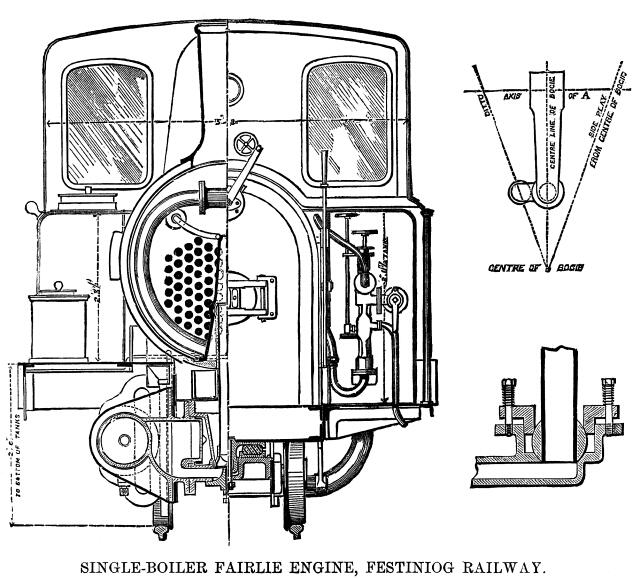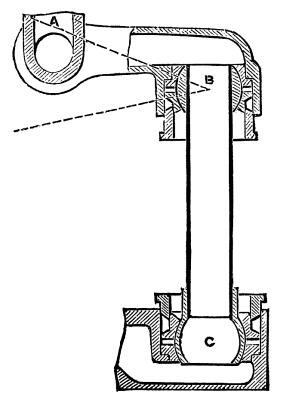NEW NARROW-GAUGE LOCOMOTIVE.
Scientific American Supplement, No.
102—December 15, 1877
 IN our SUPPLEMENT
No. 97 we gave a general elevation of a single boiler Fairlie
engine, designed by Mr. G. P. Spooner, for working the Festiniog
narrow gauge—1 ft. 11½ in.—railway. We now give
detailed drawings. It will be seen that this is a double bogie
engine, with steam cylinders attached only to the leading bogie.
The bogies are connected as usual to a carrier frame by their
centers, upon which an ordinary type of locomotive boiler rests,
the leading bogie carrying the boiler and the trailing the tender
part of the engine. The bogies turn on Adams' patent centers.
The following are the principal dimensions: Boiler: Length of
boiler, 7 ft. 7 in.; diameter of barrel outside, 2 ft. 7 in. Fire-box:
Length outside, 2 ft. 7¾ in.; average height to crown inside
from fire-bars, 2 ft. 10 in. Wheel base: Leading bogie, 4 ft.
6 in.; trailing bogie, 3 ft. 6 in. Tanks contain 380 gallons.
The principal particulars are as follows: Cylinders, 9 in. diameter,
14 in. stroke; driving wheels, 32 in. diameter (solid cast steel);
weight in steam, total, 15 tons; weight on leading bogie, 10 tons;
weight on railing bogie, 5 tons. Coal box holds 9 cwt. coal; working
load up 1 in 80, 40 tons, at fourteen miles an hour. The baffle
plate in the fire-box door is cast hollow in one piece, and perforated
on the inner side, with an adjusting slide on the outside to admit
air. All the mountings—viz., the two whistles, injector steam
cock, Widmark's waste water cock, steam gauge, and cylinder lubricating
steam cock—are all fixed on one general brass mounting in
front of the cab connected to the boiler. The steam-pipe connections
are differently arranged to those in general use. As shown in
the accompanying diagrams, the vertical movement is taken by an
elbow joint A, attached at the other end to a ball joint, IN our SUPPLEMENT
No. 97 we gave a general elevation of a single boiler Fairlie
engine, designed by Mr. G. P. Spooner, for working the Festiniog
narrow gauge—1 ft. 11½ in.—railway. We now give
detailed drawings. It will be seen that this is a double bogie
engine, with steam cylinders attached only to the leading bogie.
The bogies are connected as usual to a carrier frame by their
centers, upon which an ordinary type of locomotive boiler rests,
the leading bogie carrying the boiler and the trailing the tender
part of the engine. The bogies turn on Adams' patent centers.
The following are the principal dimensions: Boiler: Length of
boiler, 7 ft. 7 in.; diameter of barrel outside, 2 ft. 7 in. Fire-box:
Length outside, 2 ft. 7¾ in.; average height to crown inside
from fire-bars, 2 ft. 10 in. Wheel base: Leading bogie, 4 ft.
6 in.; trailing bogie, 3 ft. 6 in. Tanks contain 380 gallons.
The principal particulars are as follows: Cylinders, 9 in. diameter,
14 in. stroke; driving wheels, 32 in. diameter (solid cast steel);
weight in steam, total, 15 tons; weight on leading bogie, 10 tons;
weight on railing bogie, 5 tons. Coal box holds 9 cwt. coal; working
load up 1 in 80, 40 tons, at fourteen miles an hour. The baffle
plate in the fire-box door is cast hollow in one piece, and perforated
on the inner side, with an adjusting slide on the outside to admit
air. All the mountings—viz., the two whistles, injector steam
cock, Widmark's waste water cock, steam gauge, and cylinder lubricating
steam cock—are all fixed on one general brass mounting in
front of the cab connected to the boiler. The steam-pipe connections
are differently arranged to those in general use. As shown in
the accompanying diagrams, the vertical movement is taken by an
elbow joint A, attached at the other end to a ball joint,  which latter is on
a stiff pipe with a ball joint at each end, and not telescoping
as usual. A B takes the vertical movement from B as a center,
the lateral motion being taken by B C, with B as a center. Although
B is a suspended center, so to speak, supported by A and C. this
arrangement works admirably. It may be stated that Mr. Spooner
does not now use packing between the ball joint rings, but compresses
the top ring with spiral springs, as shown. The plan has been
at work for several years with success. The usual train for the
engine consists of which latter is on
a stiff pipe with a ball joint at each end, and not telescoping
as usual. A B takes the vertical movement from B as a center,
the lateral motion being taken by B C, with B as a center. Although
B is a suspended center, so to speak, supported by A and C. this
arrangement works admirably. It may be stated that Mr. Spooner
does not now use packing between the ball joint rings, but compresses
the top ring with spiral springs, as shown. The plan has been
at work for several years with success. The usual train for the
engine consists of
|
|
Tons |
cwt. |
Tons |
cwt. |
|
Six 4-wheel passenger cars at |
1 |
15 |
10 |
10 |
|
One 8-wheel passenger car at |
7 |
0 |
7 |
0 |
|
One 8-wheel passenger van at |
4 |
10 |
4 |
10 |
|
Six 4-wheel coal cars at |
4 |
0 |
24 |
0 |
|
TOTAL |
|
|
46 |
0 |
Single-Boiler
Fairlie Engine—Drawing
Coal cars weigh 24 tons, as above, or equal weight in empty
slate trucks or coals in empty sate trucks. The train is often
increased to 50 tons and sometimes reduced to lea than 46 tons,
making an average of 45 tons for three trips per day of nearly
fourteen miles each, up one in eighty, returning only on the down
trip with passenger cars weighing 22 tons. The average distance
run per day is eighty-five miles.—The Engineer.
Stories Page | Contents Page
|







